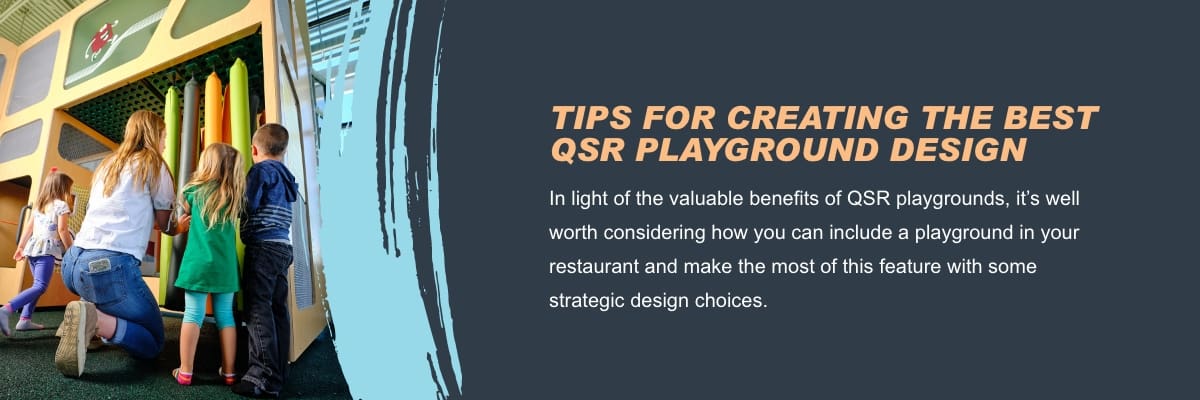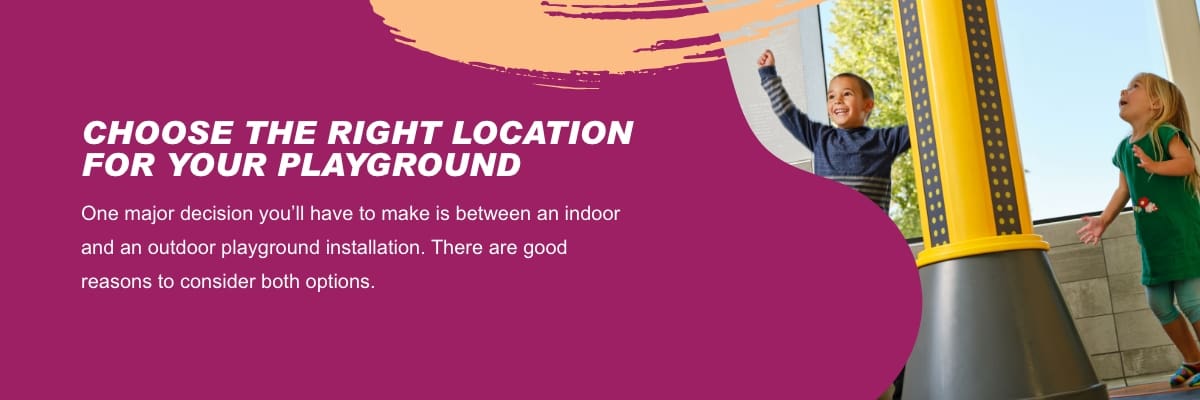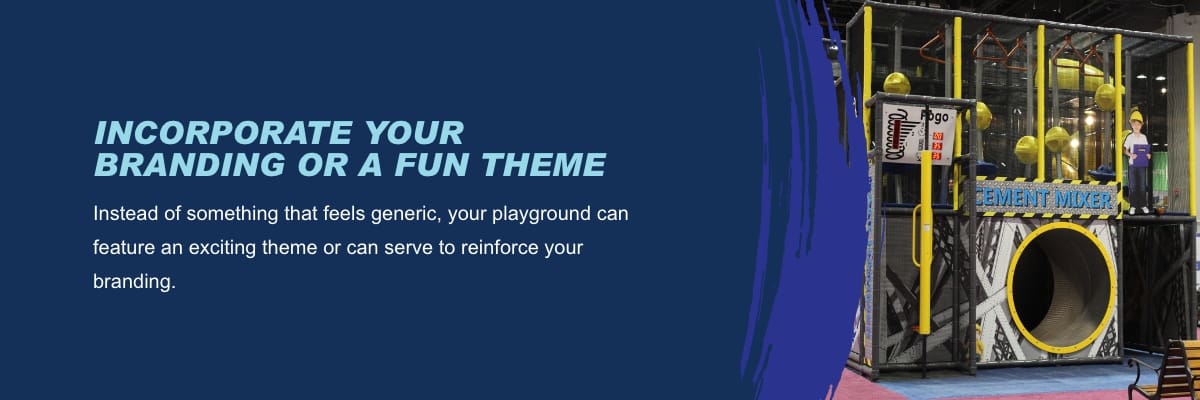Tips for QSR Playground Design

Tips for QSR Playground Design
Whether you’re starting a new quick-service restaurant (QSR) or you’re looking for ways to boost business at your existing QSR, consider installing a playground. QSR playgrounds can help you attract more customers to your restaurant and help you positively influence your community.
While the addition of a playground can be an excellent move for any QSR, not all playgrounds are created equal. You can get the most out of your investment and make your playground a real asset to your restaurant and your community by following certain design best practices and tips.
Benefits of Adding a Playground to Your Quick Service Restaurant
One of the best quick service restaurant design tips we can offer is to include a playground in your design. You may be wondering, though, why should you dedicate space to a playground? Why not give that space instead to more parking or more seating? Why should you invest financially into installing and maintaining playground equipment?

A playground is an investment of your QSR’s finances, time and available space, and it’s a strategic investment that is likely to bring a very positive return. Consider the following ways that a playground can help your business and your customers.
1. Set Yourself Apart from the Competition
With close to 200,000 franchised QSR establishments across the United States, plus independently owned QSRs, your restaurant has to distinguish itself from the competition. Of course, you can do this in many ways, including exceptional food and customer service. You can also do it by offering your customers a playground.
Anyone who frequented QSRs in the past few decades has probably noticed that playgrounds have become an increasingly rare feature. Many restaurants today have abandoned this fun feature. Several reasons may have motivated this move toward a more no-frills restaurant experience, but one thing is sure — kids are losing out. Another thing is sure, too — as the lack of a playground has become the norm, your restaurant can stand out by offering one.
A playground is an exciting feature that’s sure to set your QSR apart from the competitor across the street or next door. On the way home from school or after a busy morning running errands, where are families more likely to go for some delicious food and a nice break — the restaurant that can only fill their stomachs or the one that can also bring a smile to kids’ faces and help them burn some energy? Advertise your playground, and you’ll see customers choosing your QSR because of this novel feature.

2. Welcome Families and Groups
A playground may not make a difference to single adults or couples grabbing something to eat at your restaurant. Yet to families, it can make all the difference in helping to create a kid-friendly restaurant. Families order more food, so welcoming more families can directly translate into a boost in sales. An individual coming in may only spend a few dollars on their meal, while a family of four could easily spend much more, especially if they buy extras to share.
Along with families, a playground also welcomes larger groups of kids. For example, after the big tee-ball win, the team will be looking for a place to enjoy a bite to eat and some celebratory ice cream. You can bet they’ll pick the restaurant that also provides a place for kids to play while the parents chat and enjoy their meals. A QSR playground can also be the perfect setting for a playdate meet-up or even a birthday party. To welcome groups to the playground, include enough seating around the play area.
3. Help Kids Stay Active
You can also have a positive impact in your community by promoting active play. Kids today overwhelmingly do not get enough physical exercise. After they’ve finished their meal, most kids today will pull out a phone or tablet to keep them occupied while their parents chat and enjoy their meals. The prevalence of screen time and the major deficit of activity has become a major obstacle for kids’ health. Kids need to be active to grow and thrive developmentally and to ward off health issues like obesity and disease.
By providing a way for kids to entertain themselves while getting exercise, you can help kids in your community stay healthy. Indoor playgrounds can play an especially crucial role during the wintertime when kids may otherwise spend long sedentary hours indoors. For the price of their meal, families can take advantage of playground equipment that encourages kids to move their bodies and stay healthy.

Tips for Creating the Best QSR Playground Design
In light of the valuable benefits of QSR playgrounds, it’s well worth considering how you can include a playground in your restaurant and make the most of this feature with some strategic design choices. Let’s look at some QSR playground design ideas to help you overcome potential challenges with QSR playgrounds and make your playground an exciting attraction for kids and families.
1. Analyze Your Consumers’ Needs
Start by putting yourself in your customers’ shoes. This perspective should inform nearly every business decision you make. By understanding your consumers’ needs, you can better cater to those needs. In doing so, you can attract new customers and more repeat business.
Start by thinking specifically about your youngest customers and their parents or caregivers. According to the U.S. Department of Agriculture (USDA), households with kids purchase 19% more fast-food meals than households without kids.
Consider the reasons families choose to come to your QSR. Families are busy, so getting to skip cooking from time to time and getting their kids a meal they know they’ll love is a definite win. Parents can enjoy a break at your restaurant, and it can become even more of a break when there’s a playset there to keep kids occupied. Parents will also want to supervise their kids, of course, so you should provide plenty of tables or benches with sightlines to the play area.

What about kids? What are they looking for in a positive QSR dining experience? What sorts of playgrounds and designs are appealing to them? In creating a playground for kids, you should always keep their preferences in mind. The more you can appeal to kids, the more families will want to come to enjoy a meal and some playtime at your restaurant.
In addition to families, you should also think about your other customers. Some diners may not enjoy all the energy of exuberant kids playing nearby. Consider how you can also cater to these customers. You may choose to have your play area completely separate from the rest of your dining area or ensure some tables are spaced far enough away from the playground that diners can choose the area that best suits their preferences.

2. Choose the Right Location for Your Playground
One major decision you’ll have to make is between an indoor and an outdoor playground installation. There are good reasons to consider both options.
An outdoor playground can be a wonderful option when the weather is nice since it can help kids get more sunshine and fresh air. Of course, you’ll need to ensure you have outdoor space to install this playground and ensure there’s plenty of patio seating nearby for families to enjoy their meals. You should also make sure you locate the playground in a safe area with a clear boundary separating it from the parking lot and roadway.
Indoor playgrounds come with some advantages, as well. Since you aren’t limited to weather-proof equipment, you can choose from a wider variety of play equipment. You’ll also find it’s easier to keep an indoor playground clean since it’s in a more controlled environment without dirt, leaves or other debris affecting it.
One of the main considerations for choosing between an outdoor or an indoor playground is your climate. If your QSR is located in a mild climate where an outdoor space would be pleasant most of the time, then an outdoor playground may be a good choice.
If your area experiences harsh winters, lots of rainfall or any other factor that would make an outdoor space unusable for a good portion of the time, then you should opt for an indoor playground. An indoor space can be more convenient for you and your customers and usable year-round, no matter the weather. Especially considering that community playgrounds are generally outdoor spaces, offering a place where kids can get some exercise and have fun during the winter, a heatwave or a rainy day can be priceless to families.
3. Find Your Flow With the Right Layout
Once you map out where you’ll locate your playground, you need to figure out the layout. From users’ perspectives, the right layout can make the difference between a well-designed and a poorly designed playground. Work through these considerations to come up with your ideal layout:

- How much space do you have to work with? Start by evaluating the space you can dedicate to your play area. The good news is that even small play areas can have a big impact on your guests’ experience. If you need your playground to have a compact footprint, consider whether you have vertical space you can take advantage of. Taller play structures can be a fun and exciting way to make the most of your space. If you have more floor space, you can use it by spacing out equipment or creating different playground zones.
- Are you purchasing a preconfigured play system or separate pieces? A simple option that can save you from having to plan every aspect of your playground layout is to opt for a ready-made play system package. However, many QSR owners may want to create their own custom playground. In this instance, consider the individual pieces of equipment you want to incorporate into your play area so you can start arranging them logically.
- What will the centerpiece of the playground be? It often helps to identify the main attraction of your playground. It may be the tallest or largest piece of equipment, for example. This piece of equipment can serve as a sort of centerpiece. Figure out where you want this piece of equipment to be located first. Then, you can work your way outward, adding other pieces of equipment until your playground is complete.
- Where will kids enter and exit the playground? Ensure there are clear entry and exit points to the play area, so kids find a natural flow as they navigate the playground. Keep in mind, however, that play areas consisting of separate, freestanding pieces of equipment may not lend themselves as well to a linear flow, and that’s fine.
- How will you allow parents to supervise? It’s important to keep parents and caregivers in mind as you create your playground. Ensure that all parts of the playground are visible from tables or benches where parents will sit.
4. Appeal to Different Ages and Ability Levels
If you have limited space, you may want to focus on a specific age group with your playground. Make sure the equipment and designs you use appeal to this age group in particular. If you have room to include more equipment, then it’s smart to find ways to broaden the appeal of your playground to a wider range of ages. One of the best ways to design a playground for all ages is to create distinct zones for each general age group you want to include.
For example, you could create an area designed for toddlers and preschoolers and another area for older kids. A toddler play system might include soft-sculpted foam play pieces that small kids can climb over or otherwise interact with, along with interactive activity panels that help them develop creative and cognitive skills. A play area for older kids might include larger and more challenging types of equipment, such as higher climbers or even a rope course.
Along with age, other factors can influence kids’ abilities on the playground. Physical and mental disabilities, for example, can make some playground equipment incompatible with certain kids’ needs. This is a real problem since play is just as vital a part of childhood for kids with disabilities as it is for other kids.
It’s important to factor in these differences so all kids feel included at your QSR’s playground. By including some equipment in your design that all kids can access and enjoy, such as music equipment, you ensure that every kid sees your playground as a place for them.

5. Incorporate Your Branding or a Fun Theme
Think through how you can differentiate your QSR playground from others. Today, just having a playground automatically sets your restaurant apart from the competition, and you can further distinguish yourself by giving your playground a unique appearance. Instead of something that feels generic, your playground can feature an exciting theme or can serve to reinforce your branding.
One simple yet effective way of incorporating your branding is with a custom color palette. Is your restaurant’s logo blue and purple? Red and yellow? Yellow and green? Whatever color combination, you can create a custom playground that includes those colors so the playground feels distinctly yours. If your playground is located near a window where passersby can see it, this can even help you raise brand awareness.
You can also capitalize on brand partnerships and licensing deals to make your playground stand out. For example, kids will be excited to see a playground featuring their favorite Looney Tunes™ characters or beloved Fisher-Price® designs. If you include toys in your kids’ meals, consider a licensing deal that extends the toy characters into the playground, as well. This can help you create a cohesive marketing campaign for your youngest customers.
You can also choose fun themes for your playground that generally align with your branding or are simply imaginative and eye-catching for kids. For example, an underwater theme could be the perfect option for a restaurant known for its seafood offerings. A Fruitland theme could work well for a QSR cultivating a brand identity around health and nutrition.

6. Prioritize Hygiene With an Antimicrobial Coating
Hygiene concerns have been one of the main issues to hurt the reputation of QSR playgrounds. They are a leading reason why many restaurant owners have chosen to forgo offering playgrounds in their restaurants. These concerns should not deter restaurant owners who want to provide a healthy dose of fun for families. You can take a few steps to keep kids healthy, set parents’ minds at ease, and demonstrate care for your customers.
One simple measure you can take to limit the spread of germs on your playground is to stick to a frequent cleaning regimen. You can also install hand sanitizing stations near the playground to encourage kids to strip their hands of pathogens before and after playtime. While these steps can help you keep your QSR playground safe, there is another solution you can include in your design to make your playground exceptionally hygienic, even between cleans.
Choose Soft Play® Products for Your QSR
Soft Play has a wealth of experience creating fun, innovative playgrounds for the restaurant industry. We can help you capitalize on all the advantages of including a playground in your QSR and help you customize the playground to your needs and goals. We can work within your space and layout and incorporate your branding to make your playground ideally fit your restaurant and uniquely capture your brand identity.
Provide a place for kids to enjoy a side of fun with their meals with a QSR playground from Soft Play! Request a quote today to get started.
